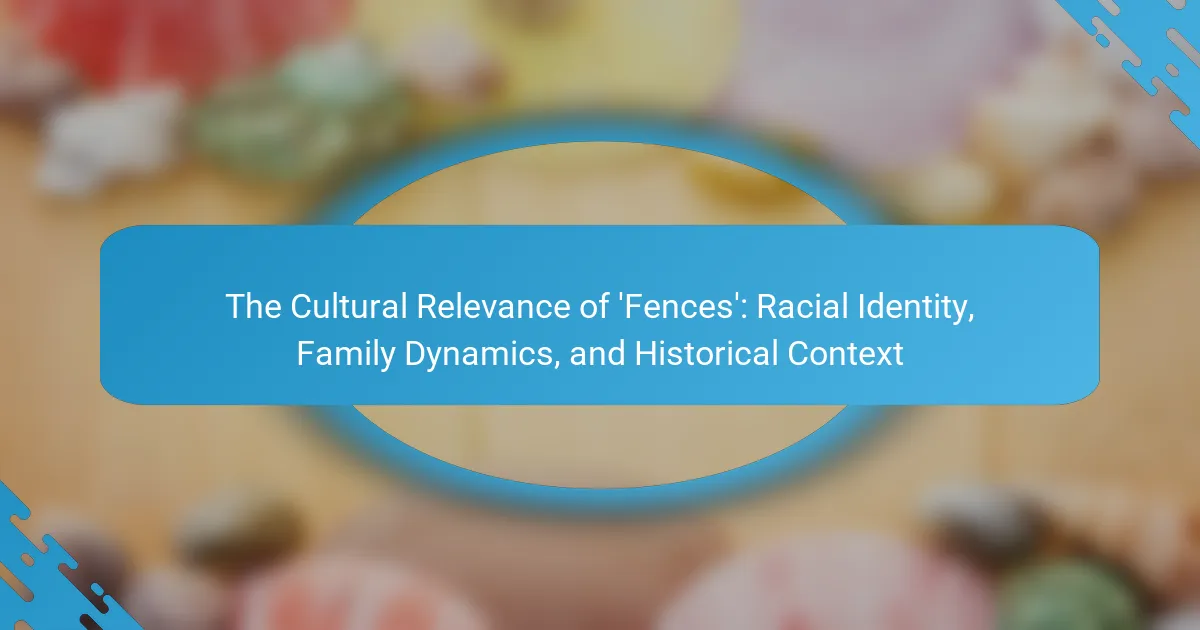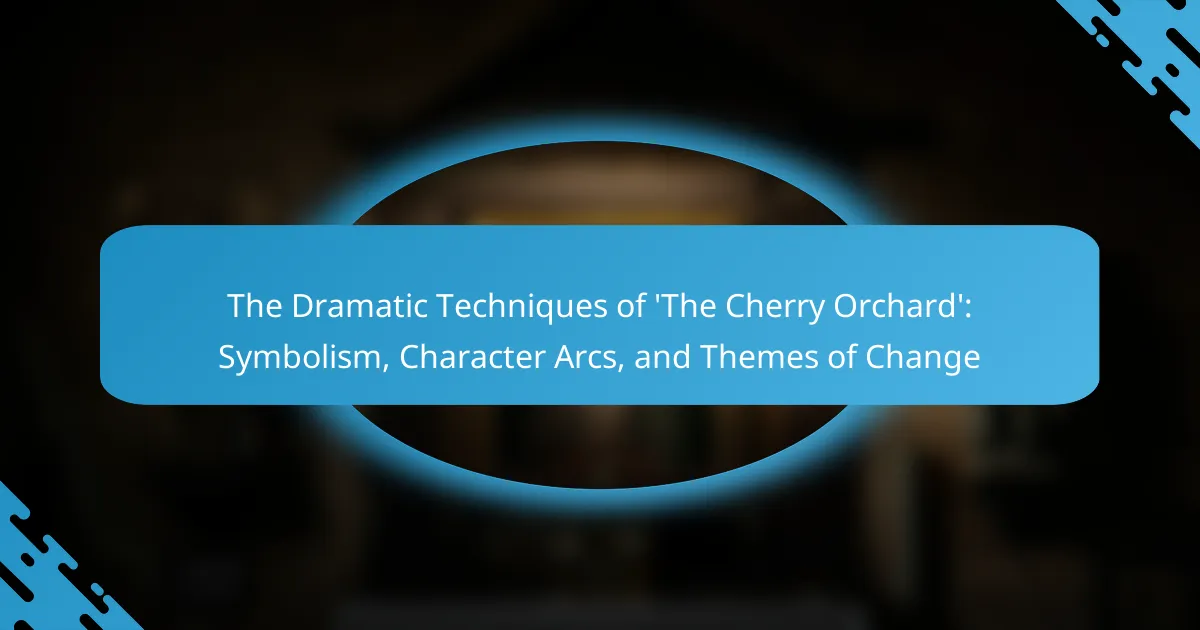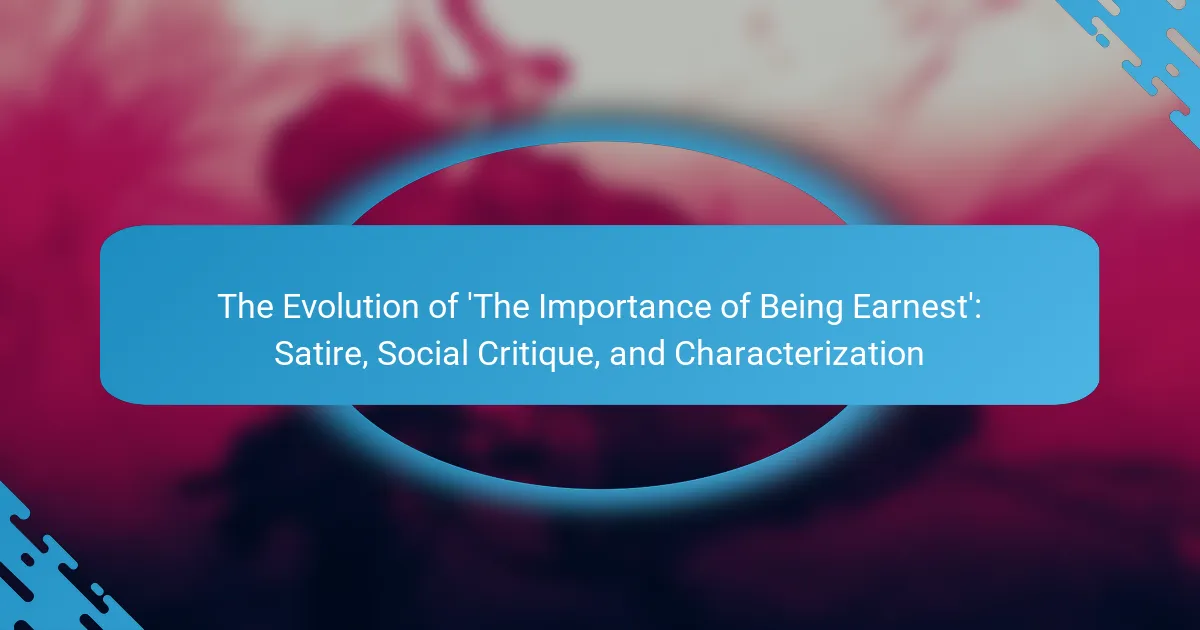‘Waiting for Godot’ is a pivotal play that delves into existential themes such as the absurdity of life, the search for meaning, and the nature of existence. The narrative follows two characters, Vladimir and Estragon, as they engage in repetitive dialogue while waiting for the ambiguous figure of Godot, symbolizing the uncertainty of human existence. The play’s cyclical structure highlights the passage of time and the futility of action, reinforcing its core themes. Additionally, it examines the dynamics of friendship amidst despair, contributing to its status as a cornerstone of absurdist theatre. The influence of ‘Waiting for Godot’ on modern theatre is significant, prompting a shift in narrative techniques and inspiring various adaptations across cultures.
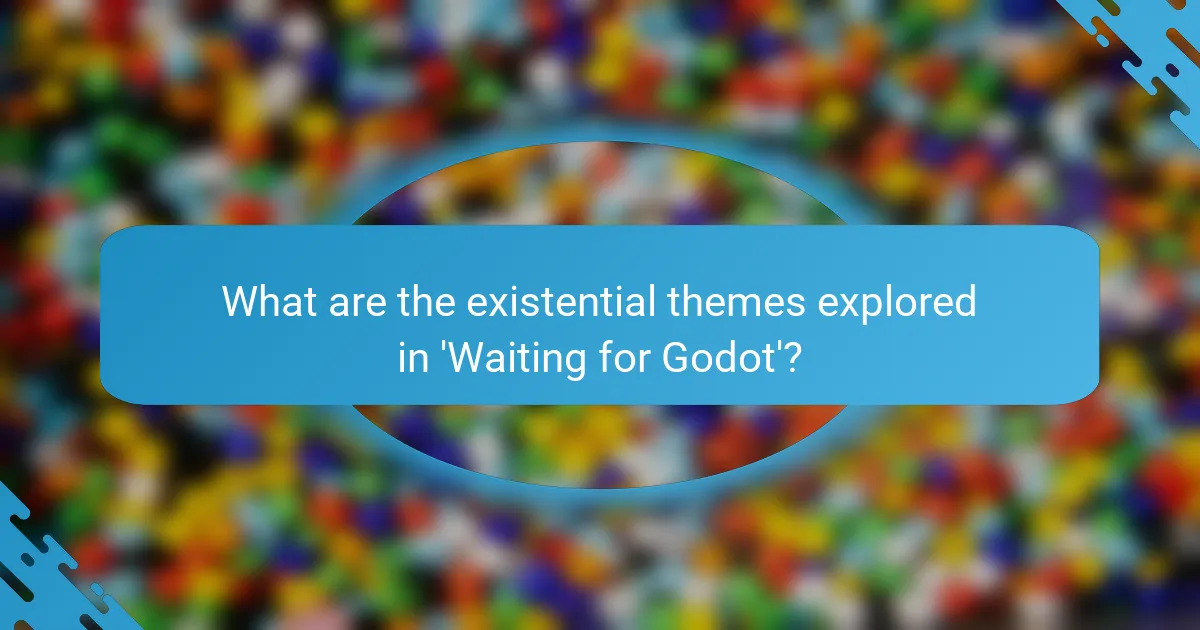
What are the existential themes explored in ‘Waiting for Godot’?
‘Waiting for Godot’ explores several existential themes, including the absurdity of life, the search for meaning, and the nature of existence. The characters, Vladimir and Estragon, engage in repetitive dialogue and actions, reflecting the futility of their situation. Their waiting for Godot symbolizes the human condition and the uncertainty of life. The theme of time is prevalent, as the characters experience a cyclical sense of waiting without resolution. Additionally, the play examines friendship and companionship amidst existential despair. The lack of a clear plot or resolution emphasizes the absurdity and randomness of existence. These themes align with existentialist philosophy, particularly the ideas of thinkers like Jean-Paul Sartre and Albert Camus. The play’s impact on theatre underscores its exploration of these profound existential questions.
How do characters in ‘Waiting for Godot’ embody existential concepts?
Characters in ‘Waiting for Godot’ embody existential concepts by illustrating themes of absurdity and the search for meaning. Vladimir and Estragon represent the human condition through their endless waiting for Godot, who never arrives. Their dialogues often reflect feelings of despair and uncertainty. They engage in repetitive actions, highlighting the futility of existence. The lack of clear purpose in their waiting symbolizes existential nihilism. Pozzo and Lucky further exemplify power dynamics and dependency. Pozzo’s authoritative behavior contrasts with Lucky’s subservience, showcasing the absurdity of human relationships. Overall, the characters’ interactions and experiences encapsulate existential themes of isolation, meaninglessness, and the human struggle for understanding.
What is the significance of waiting in the play’s narrative?
Waiting is a central theme in the narrative of “Waiting for Godot.” It symbolizes the human condition and the search for meaning. The characters, Vladimir and Estragon, wait for Godot, who never arrives. This perpetual waiting reflects existential themes of uncertainty and absurdity. The act of waiting creates tension and highlights the passage of time. It emphasizes the futility of their situation and the struggle against despair. Their conversations during the wait reveal their insecurities and hopes. Ultimately, waiting serves as a metaphor for life itself, illustrating the human experience of longing and expectation.
How does the theme of absurdity manifest in the characters’ interactions?
The theme of absurdity manifests in the characters’ interactions through illogical dialogues and repetitive actions. Characters often engage in conversations that lack clear purpose or resolution. For example, Vladimir and Estragon frequently discuss mundane topics, highlighting the futility of their situation. Their interactions reflect a sense of confusion and disconnection from reality. The absurdity is further emphasized by their waiting for Godot, a figure who never arrives. This perpetual waiting symbolizes the meaningless nature of their existence. Additionally, the characters’ attempts to find meaning often lead to contradictory statements and behaviors. This illustrates the struggle against an incomprehensible world. Overall, the absurdity in their interactions underscores the existential themes present in “Waiting for Godot.”
Why is the concept of time important in ‘Waiting for Godot’?
The concept of time is crucial in ‘Waiting for Godot’ because it underscores the play’s existential themes. Time in the play is portrayed as cyclical and ambiguous. Characters often wait for Godot, representing hope and meaning. This waiting reflects the human condition of uncertainty and despair. The lack of progression in time emphasizes the futility of their existence. Dialogue often circles back on itself, reinforcing a sense of stagnation. The play’s structure mirrors the characters’ repetitive actions, highlighting the absurdity of their situation. Overall, time serves as a vehicle for exploring deeper philosophical questions about life and purpose.
How does the perception of time affect the characters’ actions?
The perception of time significantly affects the characters’ actions in “Waiting for Godot.” Characters experience time as both cyclical and stagnant. This perception leads to a sense of hopelessness and inaction. For instance, Vladimir and Estragon wait endlessly for Godot, which symbolizes their existential struggle. Their actions often reflect a routine dictated by this waiting. The lack of urgency influences their dialogues and interactions. They engage in repetitive conversations that highlight their disconnection from time. This behavior illustrates the absurdity of their situation. Overall, their perception of time shapes their actions and underscores the play’s existential themes.
What role does the cyclical nature of time play in the narrative structure?
The cyclical nature of time in narrative structure emphasizes repetition and stagnation. In “Waiting for Godot,” time is portrayed as non-linear. Characters experience the same events repeatedly. This reinforces themes of existentialism and absurdity. The lack of progression reflects the futility of waiting. Events occur in a loop, mirroring the characters’ lives. This structure evokes a sense of hopelessness. The cyclical time enhances the overall philosophical message of the play.
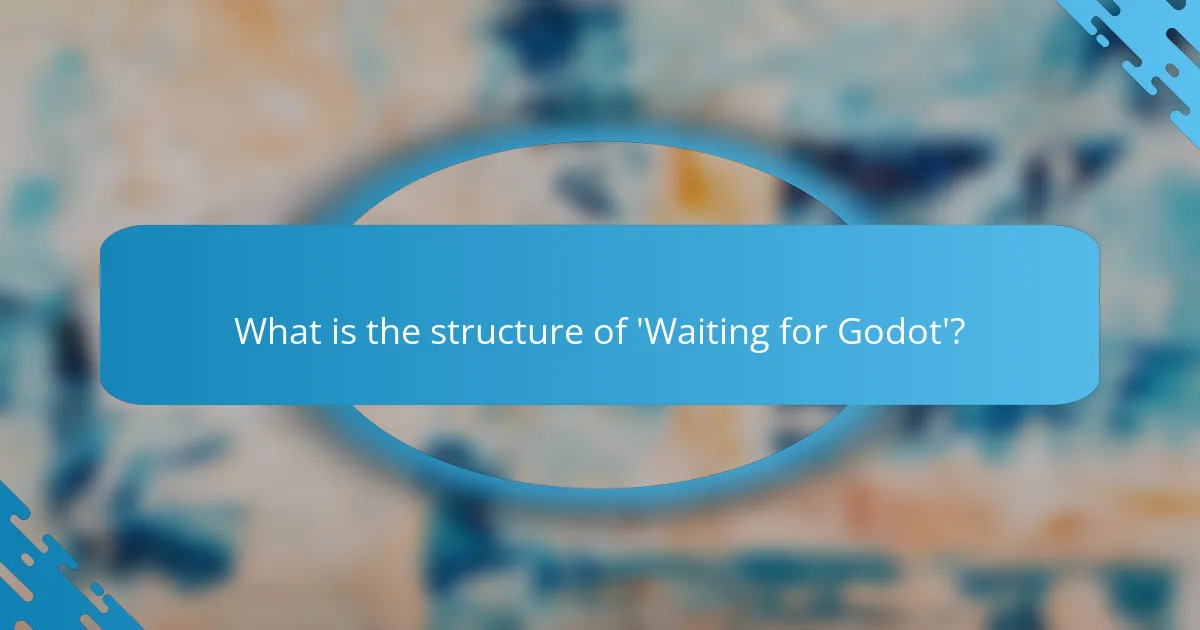
What is the structure of ‘Waiting for Godot’?
‘Waiting for Godot’ has a two-act structure. Each act presents a cyclical and repetitive narrative. The characters Vladimir and Estragon wait for the elusive Godot. They engage in various conversations and encounters. The dialogue reflects existential themes of uncertainty and absurdity. The structure emphasizes the passage of time and inaction. The lack of resolution reinforces the play’s central themes. This structure contributes to its status as a landmark of absurdist theatre.
How does the two-act format influence the storytelling?
The two-act format influences storytelling by creating a clear structure for narrative development. This format typically divides the story into two distinct parts, allowing for a setup and a resolution. In the first act, characters and conflicts are introduced, establishing the context. The second act then develops these conflicts, leading to a climax and resolution. This structure helps maintain audience engagement through pacing and tension. The two-act format can also emphasize thematic elements, such as existential questions, by allowing characters to reflect on their situations over time. In “Waiting for Godot,” this structure enhances the exploration of waiting and uncertainty, making the audience ponder deeper meanings.
What are the key events in each act that drive the plot?
In “Waiting for Godot,” the key events in each act that drive the plot involve dialogue and interactions between characters. In Act 1, Vladimir and Estragon wait for Godot while discussing various topics. They encounter Pozzo and Lucky, who introduce themes of power and dependence. The act ends with the decision to continue waiting for Godot.
In Act 2, Vladimir and Estragon repeat their wait for Godot, emphasizing the passage of time. They meet Pozzo and Lucky again, but their roles have reversed, showcasing the absurdity of their existence. The act concludes with the realization that Godot will not arrive, reinforcing the central theme of waiting and existential uncertainty.
How does the structure reflect the play’s themes of existentialism?
The structure of “Waiting for Godot” reflects existentialism through its non-linear progression and repetitive dialogue. The play lacks a traditional plot, emphasizing the absurdity of human existence. Characters Vladimir and Estragon wait indefinitely for Godot, symbolizing hope and despair. Their interactions highlight existential themes of uncertainty and the search for meaning. The cyclical nature of their conversations reinforces the idea of time’s futility. This structure mirrors existentialist beliefs about the absurdity of life. Samuel Beckett’s use of minimalism further emphasizes the characters’ isolation and existential plight. The lack of resolution underscores the existential notion that life may not have inherent purpose.
What techniques does Beckett use to create a sense of stagnation?
Beckett uses repetitive dialogue and minimal action to create a sense of stagnation. The characters often engage in circular conversations that lead nowhere. This repetition emphasizes their lack of progress or change. Additionally, the setting remains static, with the same tree and barren landscape throughout the play. Time is portrayed as fluid and undefined, enhancing the feeling of being trapped. Characters wait for Godot, who never arrives, symbolizing unfulfilled expectations. The absence of clear plot progression reinforces the theme of existential inertia. These techniques collectively illustrate the futility of their situation.
How do the dialogues contribute to the overall structure?
Dialogues in “Waiting for Godot” serve as a fundamental component of its overall structure. They create rhythm and pacing throughout the play. The repetitive nature of the dialogues emphasizes themes of existentialism and absurdity. Characters engage in circular conversations that reflect their uncertainty and despair. This structure mirrors the play’s overarching themes of waiting and inaction. Additionally, dialogues reveal character relationships and power dynamics. For instance, the interactions between Vladimir and Estragon illustrate dependency and companionship. The fragmented dialogue style contributes to the disjointed narrative, enhancing the feeling of absurdity. Overall, dialogues are essential in shaping the play’s thematic depth and structural integrity.
What is the impact of silence and pauses in the play?
Silence and pauses in the play create tension and highlight existential themes. They serve as moments of reflection for characters and the audience. These intervals emphasize the absurdity of waiting and the uncertainty of existence. In “Waiting for Godot,” pauses disrupt dialogue and force contemplation. This technique enhances the emotional weight of the characters’ plight. Silence also allows the audience to process the gravity of the situation. Critics note that these elements contribute to the play’s overall atmosphere of despair. The strategic use of silence deepens the audience’s engagement with the narrative.
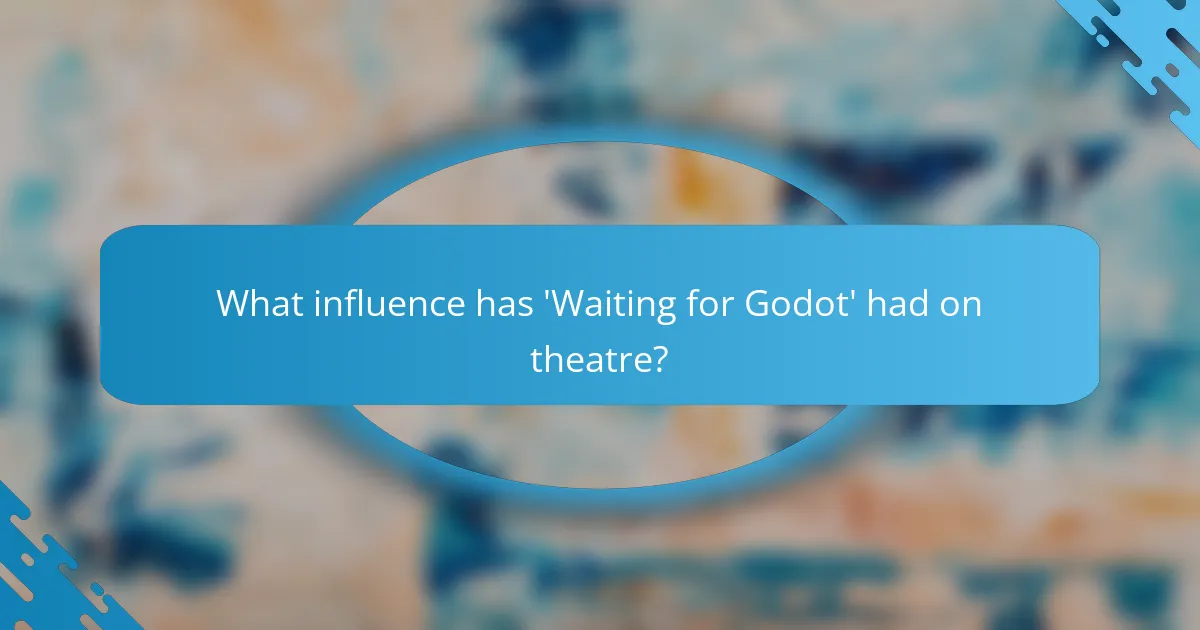
What influence has ‘Waiting for Godot’ had on theatre?
‘Waiting for Godot’ has profoundly influenced modern theatre by introducing absurdist elements. The play challenged traditional narrative structures and character development. It emphasized themes of existentialism and the human condition. This shift encouraged playwrights to explore unconventional storytelling. The work has inspired numerous adaptations and interpretations across various cultures. Its impact is evident in the works of playwrights like Samuel Beckett and Harold Pinter. Critics often cite it as a cornerstone of 20th-century drama. The play’s legacy continues to resonate in contemporary theatre practices.
How has the play shaped modern theatrical practices?
“Waiting for Godot” has significantly shaped modern theatrical practices. Its non-linear narrative challenges traditional storytelling. The play emphasizes minimalism in set design and character development. This approach has influenced many contemporary playwrights. The use of absurdist dialogue has redefined communication in theatre. It encourages audiences to interpret meaning actively. The focus on existential themes has led to deeper character exploration. This has become a hallmark of modern drama.
What are some notable productions that have reinterpreted ‘Waiting for Godot’?
Notable productions that have reinterpreted ‘Waiting for Godot’ include the 1988 production by the Gate Theatre in Dublin. This version was directed by Ian Rickson and featured a minimalist set design that emphasized the play’s themes. Another significant interpretation was the 2013 production by the New York Theatre Workshop, directed by Sean Mathias. It starred Ian McKellen and Patrick Stewart, bringing a fresh dynamic to the characters. The 2009 production at the Beckett Theatre in New York was notable for its all-female cast, offering a unique perspective on the text. Each of these productions has contributed to the ongoing dialogue about the play’s existential themes and relevance.
How has the play inspired other playwrights and genres?
“Waiting for Godot” has profoundly inspired other playwrights and genres. Its themes of existentialism and absurdity have influenced the Theatre of the Absurd movement. Playwrights like Harold Pinter and Edward Albee have drawn from its stylistic elements. The play’s non-linear narrative structure has shaped modern experimental theatre. Its focus on human despair resonates in contemporary drama. The influence extends to films and literature, showcasing its broad impact. For instance, the film “The Sunset Limited” reflects similar existential themes. “Waiting for Godot” remains a cornerstone in discussions of modern theatrical forms.
What are the cultural implications of ‘Waiting for Godot’?
‘Waiting for Godot’ reflects cultural implications of existentialism and absurdism. The play challenges traditional narrative structures. It questions the meaning of life and human existence. This resonates with post-World War II disillusionment. The characters’ endless waiting symbolizes human uncertainty. The work has influenced various art forms and literature. It has sparked discussions on the human condition and purpose. Its impact is evident in modern theatre and philosophy.
How does the play reflect societal attitudes towards existentialism?
The play “Waiting for Godot” reflects societal attitudes towards existentialism by illustrating themes of absurdity and the search for meaning. Characters Vladimir and Estragon embody the struggle of individuals confronting a seemingly meaningless existence. Their repetitive dialogues and actions highlight the futility of waiting for purpose. The setting, a desolate landscape, symbolizes isolation and the human condition. This mirrors post-World War II sentiments, where individuals grappled with existential despair. The lack of resolution in the play reinforces the notion that life may not have inherent meaning. Critics, such as Martin Esslin, have noted that the play captures the essence of existentialist thought, emphasizing choice and the burden of existence.
What relevance does ‘Waiting for Godot’ hold in contemporary discussions of meaning?
‘Waiting for Godot’ is pivotal in contemporary discussions of meaning due to its exploration of existential themes. The play illustrates the absurdity of life and the human condition. Characters Vladimir and Estragon symbolize the search for purpose in a seemingly indifferent universe. Their waiting for Godot represents the human quest for meaning. This resonates with modern audiences facing uncertainty and existential crises. The play’s structure, featuring repetitive dialogue and inaction, emphasizes the futility of waiting. Critics argue it challenges traditional narrative forms and prompts reflection on life’s inherent meaninglessness. Overall, ‘Waiting for Godot’ remains relevant as it encapsulates existential dilemmas faced in contemporary society.
What can audiences learn from ‘Waiting for Godot’ today?
Audiences can learn about the nature of existence and the human condition from ‘Waiting for Godot’ today. The play illustrates themes of waiting, uncertainty, and the search for meaning. Characters Vladimir and Estragon represent the struggle to find purpose in a seemingly indifferent world. Their interactions highlight the absurdity of life and the importance of companionship. The cyclical structure of the play emphasizes the repetitive nature of human experience. Additionally, the lack of resolution provokes reflection on hope and despair. These elements resonate with contemporary existential concerns, making the play relevant in today’s context. ‘Waiting for Godot’ challenges audiences to confront their own beliefs about existence and purpose.
How can the themes of the play be applied to modern life?
The themes of “Waiting for Godot” can be applied to modern life by illustrating the absurdity of human existence. The play emphasizes the struggle for meaning in a seemingly indifferent world. This mirrors contemporary existential concerns, where individuals often question the purpose of life. The characters’ wait for Godot symbolizes the human tendency to seek hope in uncertain situations. This reflects modern anxieties about uncertainty and the future. Additionally, the play’s exploration of friendship demonstrates the importance of companionship during difficult times. In a fast-paced society, the need for connection remains relevant. The cyclical nature of the characters’ actions highlights the repetitive patterns in daily life. This resonates with the routines many people experience today. Overall, the play’s themes encourage reflection on personal existence and the search for meaning in a complex world.
What insights can be gained from the characters’ experiences in the play?
The characters’ experiences in “Waiting for Godot” reveal profound insights about existentialism and the human condition. Their repetitive actions and dialogues illustrate the absurdity of life. This reflects the struggle for meaning in a seemingly indifferent universe. The characters’ waiting symbolizes hope and despair. Their interactions highlight themes of friendship and loneliness. The lack of resolution emphasizes the uncertainty of existence. Through their experiences, audiences gain an understanding of the complexities of human emotions. These insights resonate with the broader philosophical questions posed by existentialist thought.
‘Waiting for Godot’ is a seminal play that explores existential themes such as the absurdity of life, the search for meaning, and the nature of existence through its characters, Vladimir and Estragon. The article examines the significance of waiting, the cyclical nature of time, and how these elements reflect the characters’ experiences and interactions. Additionally, it discusses the play’s structure, its influence on modern theatre, and the cultural implications of its existentialist themes. Insights gained from the characters’ experiences highlight the complexities of human emotions and the ongoing relevance of the play in contemporary discussions of meaning.
